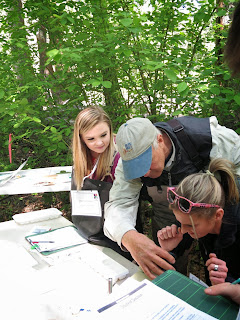On May 5, 6 and 7 approximately 300 high school
students found themselves on the scenic grounds of the Entiat Fish Hatchery for
the annual Kids in the Creek event (KITC). KITC is a hands on outdoor education
program in which high school biology students study stream ecology on the
Entiat River. Thousands of North Central Washington students have
experienced this unique learning opportunity since its inception in 1992.
 Invertebrate
Investigators- At this station the students dawn baggy, clown-sized waders
and take to the stream with nets to collect macro invertebrates. Using
microscopes, students compare their samples with identification charts to
determine which species they’ve found and get an indication of stream health.
Invertebrate
Investigators- At this station the students dawn baggy, clown-sized waders
and take to the stream with nets to collect macro invertebrates. Using
microscopes, students compare their samples with identification charts to
determine which species they’ve found and get an indication of stream health.
 Riparian RX- Students
at this station take a walk through the Entiat River’s riparian zone learning
about adaptation, the function of riparian zones, stream bank restoration and
flora and fauna interrelationships. Students are exposed to field techniques
and tools used to determine ground cover, canopy cover and overall riparian
health.
Riparian RX- Students
at this station take a walk through the Entiat River’s riparian zone learning
about adaptation, the function of riparian zones, stream bank restoration and
flora and fauna interrelationships. Students are exposed to field techniques
and tools used to determine ground cover, canopy cover and overall riparian
health.

Each day at KITC students are split into six teams which
rotate between six learning stations throughout the day. Each station is led by
resource professionals (Cascade Columbia Fisheries Enhancement Group, Chelan
County Natural Resources Department, United States Forest Service, Washington
Department of Fish and Wildlife, Team Naturaleza, Wenatchee School District,
Trout Unlimited, Ponderosa Community, AmeriCorps and the Public Utility
District) and focuses on key components of stream ecology.
 Invertebrate
Investigators- At this station the students dawn baggy, clown-sized waders
and take to the stream with nets to collect macro invertebrates. Using
microscopes, students compare their samples with identification charts to
determine which species they’ve found and get an indication of stream health.
Invertebrate
Investigators- At this station the students dawn baggy, clown-sized waders
and take to the stream with nets to collect macro invertebrates. Using
microscopes, students compare their samples with identification charts to
determine which species they’ve found and get an indication of stream health.  Riparian RX- Students
at this station take a walk through the Entiat River’s riparian zone learning
about adaptation, the function of riparian zones, stream bank restoration and
flora and fauna interrelationships. Students are exposed to field techniques
and tools used to determine ground cover, canopy cover and overall riparian
health.
Riparian RX- Students
at this station take a walk through the Entiat River’s riparian zone learning
about adaptation, the function of riparian zones, stream bank restoration and
flora and fauna interrelationships. Students are exposed to field techniques
and tools used to determine ground cover, canopy cover and overall riparian
health.
Habitat Sense – At
habitat sense students examine physical aspects of the river and discuss what
good fish habitat looks like. These attributes include riffles, glides, pools,
substrate and embeddedness.
Fish Health- As
the station title suggests, the focus here is fish health and the environmental
factors that affect fish. Students also learn about fish anatomy and
environmental stressors.
Stream Flow- At
this station students use mathematical equations they’ve learned in the
classroom to calculate the stream flow of a side channel of the Entiat River.
After calculating the flow, the students discuss what varying flows mean for
the ecosystem, especially at extreme high and low flows.
Water Quality- Here,
students learn to measure the pH, turbidity, dissolved oxygen and temperature
of a river. They then use these measurements to discuss and quantify stream
health.

Upon completing each station, at the end of the day, each
team is charged with coming up with a management plan for a swath of riverside
property. These plans are then presented to peers and several resource professionals
who critique each plan.
This year’s KITC was a huge success. Everything went just as
planned and everyone involved learned something they could take with them. A few
of the participating Wenatchee High School students were asked what they
learned at KITC. This is how one replied: “it is important to us to have
healthy streams…we really affect our watershed.”
Cascadia would like to thank Entiat Fish Hatchery for
providing a beautiful venue, Alcoa and South Douglas Conservation District for
their funding, and the Entiat Volunteer Service group for all their hard work
and support. We would also like to thank all the resource professionals who
came out to share their knowledge with the next generation of land managers!
Below are more Wenatchee High School students’ replies when
asked what they learned at KITC.
* How important riparians are; why it is important to us to
have healthy streams; how we really affect our watershed.
*That fish need healthy/non-polluted water to live; all
streams have different habitat for different bugs; that biologists have very
hands on jobs.
* It's very important to keep our environment clean for the
Wenatchee watershed.
* That learning can be fun; you don't always learn in
classrooms; hands on is good.
* It was fun to learn more stuff about the land; I thought
it was going to be boring but it was fun; that fish and trees need to be helped
and saved from being turned into stores and homes.
Today's snowpack in North Central Washington is 31% of its 29 year average (ftp://ftp.wcc.nrcs.usda.gov/data/water/wcs/gis/maps/wa_swepctnormal_update.pdf).




.JPG)
.JPG)